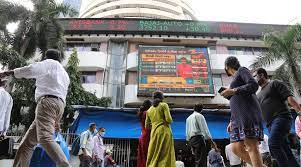http://sharetipsinfo.comJust get registered at Sharetipsinfo and earn positive returns

Share Market closing Note
Benchmark indices ended lower with Nifty below 17600 mainly dragged by IT, metal, power and oil & gas stocks.
At Close, the Sensex was down 770.48 points or 1.29% at 58,766.59, and the Nifty was down 216.50 points or 1.22% at 17,542.80. About 1904 shares have advanced, 1446 shares declined, and 142 shares are unchanged.
Hindalco Industries, Reliance Industries, ONGC, TCS and SBI Life Insurance were among top losers on the Nifty, while gainers were Tata Consumer Products, Bajaj Finserv, Asian Paints, Eicher Motors and Hero MotoCorp.
Except realty, capital goods, PSU bank and auto, all other sectoral indices ended lower.
BSE midcap and smallcap indices rose 0.5% each.
--------------------------------------------------------------------------------------------
Topic :- Time:3.00 PM
Nifty spot if holds above 17520 level on closing basis then expect some further recovery in coming sessions and if it closes below above mentioned level then some sluggish movement can follow. Avoid open positions for tomorrow.
--------------------------------------------------------------------------------------------
Topic :- Time:2.00 PM
Nifty is declining regularly. Nifty spot if breaks and trade below 17480 level then expect some further decline in the market and if it manages to trade and sustain above 17520 level then some upmove can follow in the Nifty. Currently nifty spot is trading at 17485.
--------------------------------------------------------------------------------------------
Topic :- Time:1.30 PM
GOLD Trading View:
GOLD is trading at 50230.If it manages to trade and sustain above 50260 level then expect some quick upmove in it and if it breaks and trade below 50180 level then some decline can follow in Gold.
--------------------------------------------------------------------------------------------
Topic :- Time:1.20 PM
Just In:
Car dispatches up nearly 30% in August.
--------------------------------------------------------------------------------------------
Topic :- Time:1.10 PM
Just In:
Jet fuel price slashed in Delhi after govt hikes windfall profit tax.
--------------------------------------------------------------------------------------------
Topic :- Time:1.00 PM
Nifty is declining again however its still rangebound and pull back can be seen soon. Nifty spot if breaks and trade below 17550 level then expect some decline in the market and if it manages to trade and sustain above 17580 level then some upmove can follow in the market.
--------------------------------------------------------------------------------------------
Topic :- Time:12.30 PM
COPPER Trading View:
COPPER is trading at 642.If it manages to trade and sustain above 643.50 level then expect some upmove in it and if it breaks and trade below 640.90 level then some decline can follow in it.
--------------------------------------------------------------------------------------------
Topic :- Time:12.30 PM
COPPER Trading View:
COPPER is trading at 642.If it manages to trade and sustain above 643.50 level then expect some upmove in it and if it breaks and trade below 640.90 level then some decline can follow in it.
--------------------------------------------------------------------------------------------
Topic :- Time:12.00 PM
After gap down opening nifty recovered a bit however it is still trading in red zone. Nifty spot if manages to trade and sustain above 17620 level then expect some upmove in the market and if it breaks and trade below 17580 level then some decline can follow in the Nifty.
--------------------------------------------------------------------------------------------
Topic :- Time:11.30 AM
News Wrap Up:
1. Sensex trims early loss, down 350 pts; Nifty below 17,650
2. Manufacturing PMI dips slightly to 56.2 in August from 56.4 in July
3. NDTV says stake sale to Adani needs approval from tax authorities
4. Govt hikes windfall profit tax on export of diesel, jet fuel: FinMin
5. India Incs foreign investment declines over 50% to $1.11 bn in July
6. Amid Chinas slowdown, Asian manufacturing hubs see dip in demand
7. Markets log 3rd highest monthly FPI inflows since Covid outbreak in August
8. Ashok Leyland rallies 5% on bagging order for 1,400 school buses in UAE
9. Biocon sheds 4%, hits 52-week low as US FDA issues form 483 for 3 sites
10. Adani stocks outperform indices, Zomato down 57.8% in 2022 so far
--------------------------------------------------------------------------------------------
Topic :- Nifty Opening Note
Indian Stock Market Trading View For 01 Sept,2022:
Nifty is likely to remain volatile and is expected to follow global cues.
Nifty spot if manages to trade and sustain above 17800 level then expect some upmove in the market and if it breaks and trade below 17720 level then some decline can follow in the Nifty. Please note this is just opening view and should not be considered as the view for the whole day.
--------------------------------------------------------------------------------------------